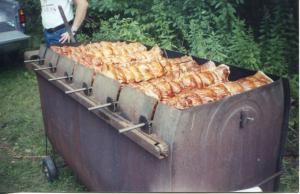2016 - Volume #40, Issue #3, Page #03
[ Sample Stories From This Issue | List of All Stories In This Issue | Print this story
| Read this issue]
Rotisserie Roaster Made Out Of Fuel Oil Tank
 |
The 2-ft. wide by 5-ft. long roaster is used to cook everything from chickens to beef, turkey, and whole pork loins. It has a pair of small wheels at one end and big handles at the other so Robinson can move it around like a wheelbarrow.
The roaster is fitted with six 3-ft. long “spits” which consist of 1/2-in. dia. metal rods with small sprockets welded onto them. The spits ride in 4-in. deep slots cut into both sides of the tank. An electric gearhead motor drives a chain that rotates the sprockets. The chain rides over a length of square tubing welded onto one side of the tank, making a continuous loop while driving the sprockets.
The fire consists of 8 to 10 small sticks of wood that burn at the bottom of the tank.
“It works perfect,” says Robinson. “I can cook several different kinds of meat at a time - turkey, pork, beef, chickens, etc. I’ve cooked 18 whole 8-lb. chickens in it, and it can easily handle twelve 14-lb. turkeys, too.”
The spits are 3 ft. long on a 2-ft. wide roaster in order to provide a handle, and they’re pointed at one end to slide the meat on. “I tie pork loins with butcher twine so they can’t wiggle around on the spits and offset the balance and also cook unevenly,” says Robinson. “If I want, I can remove a spit or move it to another location without having to stop the motor. And if some meat gets done before the others, I pick up the spit and move it back where there’s less heat.
“I try to use split wood instead of round because it’s bark-free, and too much bark can produce an unpleasant smelling smoke. A 4-hour cook time uses only a large armful of wood.”
Robinson says he generally operates the motor at 3 to 5 rpm’s and keeps the flame no higher than 10 to 12 in. “I’m careful to never let the ashes get wet because if that happens, the next time I build a fire there will be an unpleasant odor,” he says.
He used a sawzall to cut off the top of the tank and then drained away all the oil. He then built a small fire at both ends of the tank, keeping it burning for 4 to 5 hrs. in order to remove any oil smell.
“When I cut through the tank I saved the top to serve as a lid, but I’ve never had to use it because I always make sure the roaster stays dry,” notes Robinson.
Contact: FARM SHOW Followup, Forrest A. Robinson, 1072 Rt. 12, Westmoreland, N.H. 03467 (ph 603 399-4815; violetterobinson@)gmail.com).

Click here to download page story appeared in.

Click here to read entire issue
To read the rest of this story, download this issue below or click here to register with your account number.




